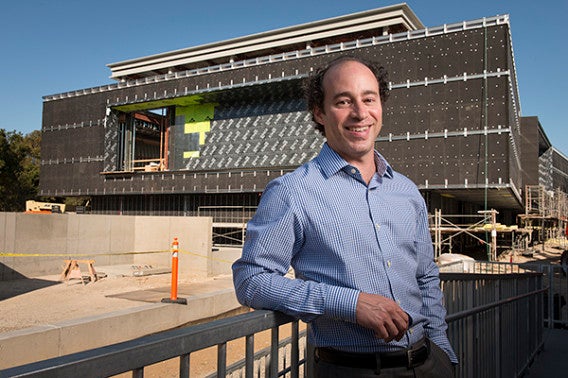|
September 30, 2013
Jason Linetzky named first director of the Anderson Collection at Stanford University
The longtime manager of the Anderson family's extensive private art collection will shepherd the core of the collection from its current residential home to a new home in the university's developing arts district. By Robin Wander

Jason Linetzky is the director of the Anderson Collection at Stanford University, which opens to the public in fall 2014. (Photo: Linda A. Cicero / Stanford News Service)
Jason Linetzky has spent the better part of his 20-year career working with one of the world's most coveted private collections of 20th-century American art: the Anderson Collection. The collection was built over the last 50 years by Bay Area residents Harry W. and Mary Margaret Anderson, and by their daughter, Mary Patricia Anderson Pence.
The core of the collection, pledged to Stanford in 2011, is a significant marker for the Stanford Arts Initiative, which supports the university's commitment to the arts.
In what is a turning point for Linetzky and the collection, he becomes the first director of the Anderson Collection at Stanford University, which opens to the public in fall 2014.
Born in the Midwest, raised on the East Coast, educated at American University in Washington, D.C., and transplanted to the Bay Area about 17 years ago, Linetzky says he is delighted to be joining the Stanford community.
"Having worked with the Anderson family and understanding their goals, it's phenomenal that Stanford is providing a spectacular platform for sharing their collection with the broadest of audiences," said Linetzky about the display of the collection in the new Anderson Collection building.
A plan to construct a building dedicated to displaying and interpreting the 121 works spanning seven decades was enthusiastically approved by the Stanford Board of Trustees the same year the transformative gift was announced. Ground was broken in 2012 and the building is on schedule to open next fall.
Linetzky has been an integral part of the collection's remarkable development. Next year he will shepherd the move from family bedrooms and corporate boardrooms to a 33,000-square-foot building designed by Ennead Architects.
"Family collections are unique in that they tell the story of relationships – with artists, dealers, curators, scholars and many others. This collection is certainly an historical one in that it represents key modern and contemporary American art movements, but at the same time, and just as importantly, it represents the collective choices and tastes of the family who built it," Linetzky said.
"Maintaining the care, custody and control of the collection up until now has been a tremendous pleasure, and I am excited to engage with campus partners and collaborate on presenting the objects and their stories in ever-unfolding ways."
Linetzky will be responsible for the presentation of the Anderson Collection and the operation of the new space, but the immediate focus is hiring staff, planning the inaugural exhibition, editing the accompanying catalog and overseeing docent training. He also will be building partnerships on campus. Partners include his arts district neighbors, the Cantor Arts Center and Bing Concert Hall, and future neighbor the Department of Art and Art History in the new McMurtry Building scheduled to open in 2015, but he also is interested in reaching out to engineering and science departments.
"The imminent arrival of the Anderson Collection and Jason's appointment at Stanford mark an important crossroad in the university's path toward excellence in the visual arts," said Nancy Troy, chair of the Department of Art and Art History.
Linetzky's extensive experience with all aspects of fine arts management – research, curating, conservation, installation, lending – and broader interest in all the arts will serve the university well because of the interdisciplinary emphasis on campus.
Before working with the Anderson Collection, Linetzky was an independent curator, a film festival director and curator, and a commercial gallery founder who worked in the areas of antiques, decorative arts, tribal/ethnic and emerging arts.
"Exposure to the arts and the support I received from an early age provided me with an opportunity to pursue my interests in this field. Stanford's bold, sustained commitment to increasing the presence and accessibility of the arts creates just such an opportunity for generations to come."
-30-
|